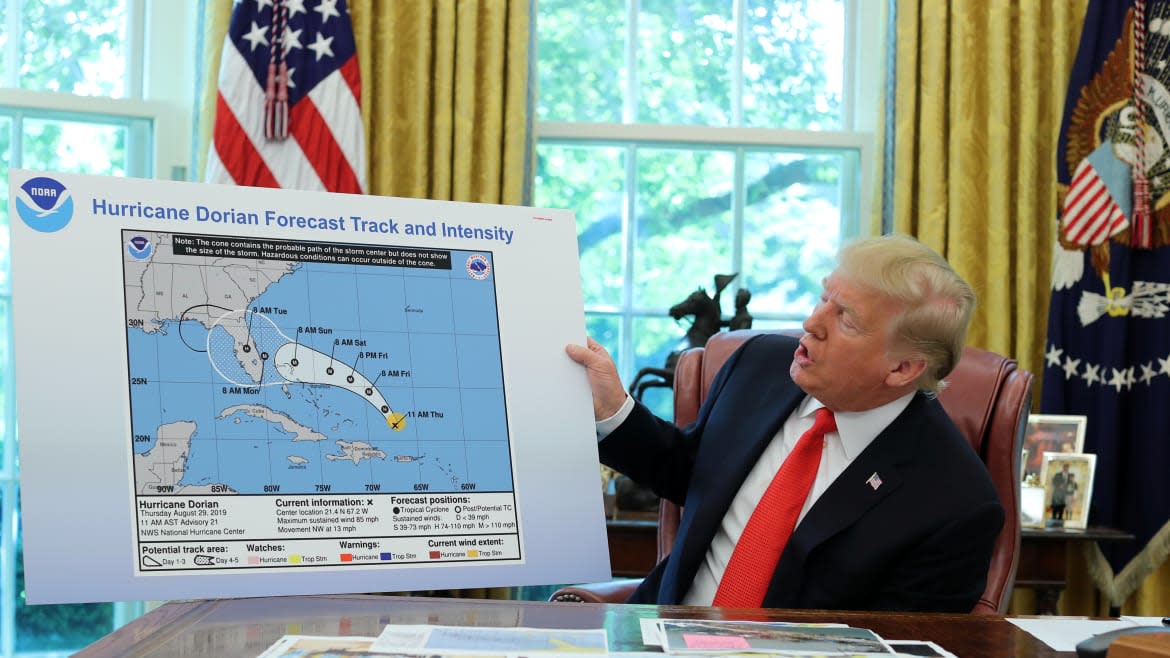Emails Show Government Agency Melting Down Over Trump’s Hurricane Fiasco: ‘This Has Really Gotten Out of Hand’

In early September, as Hurricane Dorian battered the East Coast, President Donald Trump didn’t want to admit he was wrong about the storm’s impact in a tweet he had sent, so he instead dug in, dragged senior government officials into his charade, and even hosted reporters in the Oval Office to show them a days-old forecast map that he’d personally altered to prove that Alabama was in danger when it really wasn’t.
It was yet another bizarre, protracted episode of the Trump presidency and one that, as emails released under the Freedom of Information Act show, created massive internal headaches for personnel at various agencies. (The Daily Beast was among the news outlets that requested these communications under the FOIA.) One top official said that workers directly involved in handling hurricane response were forced to turn their cellphones off because of the influx of media calls seeking an explanation for the president’s tweets and his accompanying efforts to prove he’d been right about Alabama all along.
“This has really gotten out of hand,” Chris Darden, the meteorologist in charge at the National Weather Service office outside Birmingham, Alabama, wrote in an email dated Sept. 5.
The internal response and email traffic provides a window into just how much Trump can upend the functions of a government in the midst of a crisis—all in the service of satisfying his pet grievances or fleeting fixation of the moment.
The incoming emails appeared to truly start deluging on Sept. 4, after Trump held an Oval Office event at which he displayed a map of the country on which he had scribbled, with a Sharpie, an extended cone designed to show that Alabama had been in the path of Dorian. Earlier the National Weather Service office in Birmingham had insisted that the state was not in danger. And with the president now directly—if not hamfistedly—contradicting that proclamation, the calls and emails began arriving in bulk.
“Thanks,” Christopher Vaccaro, a spokesman at NOAA headquarters in Washington, D.C., wrote to Jerry Slaff in NOAA’s National Ocean Service, who had flagged the video of Trump’s Sharpie display, “we are aware and inquiries are pouring in.”
The next day, the president tweeted out an old, outdated map with extended cones that showed Alabama had a small percentage chance of seeing heavy winds. That’s when Darden warned that things were getting out of hand.
“One of my forecasters just messaged me and said CNN is contacting him on his personal twitter asking for comment,” he wrote in an internal email.
That afternoon, NOAA decided to put out an unsigned statement that backed the president’s assertion that Alabama was in the crosshairs. Inside the building, the decision clearly left personnel upset.
Alek Krautmann, a NOAA programmer, wrote to John Leslie, a public affairs officer, to note that the “statement is deeply upsetting to NOAA employees that have worked the hurricane and not fully accurate based on the timeline in question.” Krautmann encouraged Leslie to “raise this in feedback through proper channels.”
Trevor Noah Nails Trump for Doctoring Hurricane Dorian Map
From there, things just got worse. Staff were on the receiving end of blistering emails from angry citizens and concerned scientists who said the statement represented a low point for the agency. Susan Buchanan, the director of public affairs for the National Weather Service, emailed to say that NWS employees in Pennsylvania were “receiving a lot of angry/hate mail and phone calls on our cell phones about the statement NOAA released yesterday.”
“I wanted leadership to have the best situational awareness of the fallout,” Buchanan wrote. “People are finding us on LinkedIn and targeting us with hate mail from there as well.”
Mary Erickson, the National Weather Service’s deputy director, wrote back to say that “media is also targeting [Weather Forecast Offices] folks on personal phones and emails. It [sic] creating a growing concern about impacting our connections to [Emergency Managers], since leaders at some WFO’s have had to turn off their cell phones due to the large volume of calls.”
Benjamin Friedman, NOAA’s deputy under secretary for operations, responded that he, too, had been ”targeted as well.”
“This is a difficult time,” he added. “I know that political leadership is discussing next steps.”
But by later that evening things had only gotten worse. Friedman forwarded an email he had received from a woman identifying as a scientist who had studied oceanography with former NOAA administrator Kathryn Sullivan. In it, the person had laced into the agency for the statement it put out, accusing the agency leader of having a “boot-licking, pandering attitudes” and encouraging him to “grow a pair or get out.”
“These are getting very personal,” Friedman wrote.
Got a tip? Send it to The Daily Beast here
Get our top stories in your inbox every day. Sign up now!
Daily Beast Membership: Beast Inside goes deeper on the stories that matter to you. Learn more.

